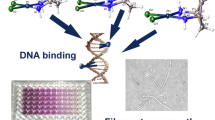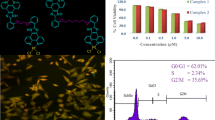Abstract
The search for platinum (II)-based compounds with improved therapeutic properties was prompted to design and synthesize a new family of water-soluble, third generation cis-diamminedichloroplatinum (II) complexes linked to uracil and uridine. Six heretofore undescribed uracil and uridine-platinum (II) complexes are; [N-(2-aminoethyl)uracil-5-carboxamide]dichloroplatinum (II) (3a), [N-(2-aminoethyl)uracil-6-carboxamide]dichloroplatinum (II) (3b), [5-(2-aminoethyl)carbamoyl-2′,3′,5′,-tri-O-acetyluridine] dichloroplatinum (II) (6b), [5-(2-aminoethyl) carbamoylu-carbamoyl-2′,3′,5′,-tri-O-acetyluridine] dichloroplatinum (II) (6b), [5-(2-aminoethyl)carbamoyluridine]dichloroplatinum (II) (7a), [6-(2-aminoethyl)carbamoyluridine]dichloroplatinum (II) (7b).
These analogues were prepared from the key starting materials, 5-carboxyuracil (1a) and 6-carboxyuracil (1b) which were reacted with ethylenediamine to afford the respective N-(2-aminoethyl)uracil-5-carboxamide (2a) and N-(2-aminoethyl)uracil-6-carboxamide (2b). The cisplatin complexes3a and3b were obtained through the reaction of the respective2a and2b with potassium tetrachloroplatinate (II). The heterocyclic nucleic acid bases1a and1b were efficiently introduced on the β-D-ribose ring via a Vorbruggen-type nucleoside coupling procedure with hexamethyldisilazane, trimethylchlorosilane and stannicchloride under anhydrous acetonitrile to yield the stereospecific β-anomeric 5-carboxy-2′,3′,5′-tri-0-acetyluridine (4a) and 6-carboxy-2′,3′,5′-tri-0-acetyluridine (4b), respectively. The nucleosides4a and4b were coupled with ethylenediamine to provide the respective 5-(2-aminoethyl)carbamoyl-2′,3′,5′-tri-0-acetyluridine (5a) and 6-(2-aminoethyl)carbamoyl-2′,3′,5′-tri-0-acetyluridine (5b). The diamino-uridines5a and5b were reacted with potassium tetrachloroplatinate (II) to give the novel nucleoside complexes,6a and6b, respectively which were deacetylated into the free nucleosides,7a and7b by the treatment with CH3ONa. The antitumor activities were evaluated against three cell lines (K-562, FM-3A and P-388).
Similar content being viewed by others
References Cited
Andrews, P. A.; Howell, S. B. Cellular Phamacology of Cisplatin: Perspectives on Mechanisms of Acquired Resistance,Cancer Cell, 2, 35–43 (1990).
Bitha, P.; Carvajal, S. G.; Citarella, R. V.; Child, R. G.; DelosSantos, E. F.; Dunne, T. S.; Durr, F. E.; Hlavka, J. J.; Lang, Jr, S. A.; Lindsay, H. L.; Morton, G. O.; Thomas, J. P.; Wallace, R. E.; Lin, Y. L.; Haltiwanger, R. C.; Pierpont, C. G.; Water-Soluble-Third Generation Antitumor Platinum Complexes, [2,2-Bis(aminomethyl)-1,3-propanediol N,N′]-[1,1-cyclo-butanedicarboxylato(2-)-0,0′]platinum(II) and [1,1-cyclobutanedicarboxylato(2-)-0,0′][tetrahydro-4H-4,4-dimethanamine-N,N′]platinum (II).J. Med. Chem., 32, 2015–2020 (1989).
Burchenal, J. H.; Kalahar, K.; Dew, K.; Lokys, L.. Rationale for Development of Platinum Analogs.Cancer Treat. Rep., 63, 1493–1498 (1979).
Carmichael, J., Degraff, W. G., Gazdar, A. F., Minna, J. D., and Mitchel, J. B., Evaluation of a Tetrazolium based Semiautomated Colorimetric Assay: Assessment of Chemo-sensitivity Testing.Cancer Res., 47, 936–938 (1987).
Harland, S. J.; Smith, I. E.; Smith, N.; Alison, D. L. Platinum Coordination Complexes in Cancer Chemotherapy, Hacker, H. P.; Douple, E. B.; Krakoff, I. H., Eds.; Martius Nihoff, Pullishing, Boston MA, 1984, p 352.
Kim, J. C.; Dong, E. S.; Park, J. I.; Bae, S. D.; Kim, S. H. 5-Substituted Pyrimidine Acyclic Nucleoside Analogues 1-Cyanomethyl-and 1-(4-Cyanobutyl)-5-Substituted Uracil as Candidate Antitumor Agents,Arch. Pharm. Res., 17, 480–482 (1994a).
Kim, J. C., Lim, Y. G., Min, B. T., Park, J. I., Preparation of N′-substituted Anilino-N-Methyl-N′-Nitrosoureas as Candidate Anititumor Agent.Arch. Pharm. Res., 17, 420–423 (1994b).
Kim, J. C., Bae, S. S., Kim, S. H., Kim, S. H., Synthesis andIn Vitro Cytotoxicity of a Homologous Series Of 9-[ω-N′-methyl-N′-nitrosoureido)alkyl] purine. Korean.J. Med. Chem., 4, 66–72 (1994c).
Korolkovas, A.. Essentials of Medicinal Chemistry, 2nd. Ed., J. Wiley and Sons: New York, 1988, p875.
Mosmann, T., Rapid Colorimetric Assay for Celluar Growth and Survival: Application to Proliferration and Cytotoxity Assay.J. Immunol. Methods, 65, 55–63 (1983).
Nicolini, M., Ed., Platinum and Other Coordination Compound in Cancer Chemotherapy, Maitinus-Nijhoff Publishing, Boston, 1988.
Author information
Authors and Affiliations
Rights and permissions
About this article
Cite this article
Kim, J.C., Kim, MH., Kim, SH. et al. Synthesis of a series ofcis-diamminedichloro-platinum (II) complexes linked to uracil and uridine as candidate antitumor agents. Arch. Pharm. Res. 18, 449–453 (1995). https://doi.org/10.1007/BF02976350
Received:
Issue Date:
DOI: https://doi.org/10.1007/BF02976350
Key words
- cis-Diamminedichlorplatinum (II)
- [N-(2-Aminoethyl)uracil-5-carboxamide]dichloroplatinum (II)
- [N-(2-Aminoethyl)uracil-6-carboxamide]dichloroplatinum (II)
- [5-(2-Aminoethyl)carbamoyl-2′,3′,5′-tri-0-acetyluridine] dichloroplatinum (II)
- [6-(2-Aminoethyl)carbamoyl-2′,3′,5′-tri-0-acetyluridine] dichloroplatinum (II)
- [5-(2-Aminoethyl)carbamoyl uridine]dichloroplatinum (II)
- [6-(2-Aminoethyl)carbamoyl uridine]dichloroplatinum (II) β-anomeric 5-carboxy-2′,3′,5′-tri-0-acetyluridine
- 6-carboxy-2′,3′,5′-tri-0-acetyluridine
- 5-(2-Aminoethyl)carbamoyl-2′,3′,5′-tri-0-acetyluridine
- 6-(2-Aminoethyl)carbamoyl-2′,3′,5′-tri-0-acetyl)uridine
- antitumor activities
- Human chronic myelogenous leukemia cell (K562)
- Mouse lymphoid neoplasma cell (P-388)
- Mouse mammary carcinoma cell (FM-3A)




